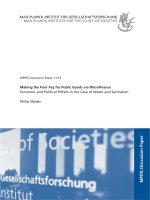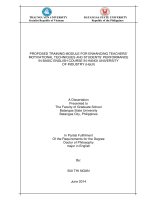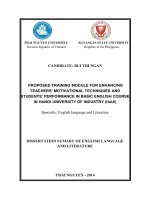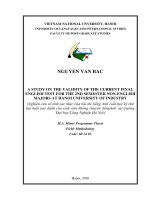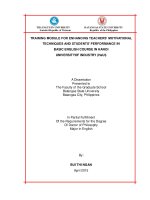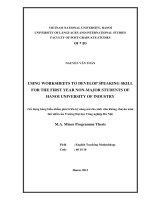proposed training module for enhancing teacher’s motivational techniques and students’ performance in basic english course in hanoi university of industry (haui) (sum)
Bạn đang xem bản rút gọn của tài liệu. Xem và tải ngay bản đầy đủ của tài liệu tại đây (318.45 KB, 25 trang )
THAI NGUYEN UNIVERSITY BATANGAS STATE UNIVERSITY
Socialist Republic of Vietnam Republic of the Philippines
CANDIDATE: BUI THI NGAN
PROPOSED TRAINING MODULE FOR ENHANCING
TEACHERS’ MOTIVATIONAL TECHNIQUES AND
STUDENTS’ PERFORMANCE IN BASIC ENGLISH COURSE
IN HANOI UNIVERSITY OF INDUSTRY (HaUI)
Specialty: English language and Literature
DISSERTATION SUMARY OF ENGLISH LANGUAGE
AND LITERATURE
THAI NGUYEN - 2014
The study was done at:
INTERNATIONAL GRADUATE STUDY PROGRAMS,
THAI NGUYEN UNIVERSITY
Scientific supervisor: Dr. Maltida H. Dimaano
The peer review 1:
The peer review 2:
The peer review 3:
The dissertation is defended to the Panel of Experts at:
Dissertation can be found at:
- National Library
- Learning Resource Center, Thai Nguyen University
- Library of International Training and Development Center
- Library of Batangas State University, Philippines
1
Chapter 1
THE PROBLEM
INTRODUCTION
Teaching English in various places at all levels expanding
educational system in Vietnam is part of the mounting pressures
where knowledge and ability to learn and communicate in
English is a must and of importance. Vietnamese students have
to pass an English language test being one of their six national
examinations for them to get the certification for Secondary
school education. Undergraduates and graduates of tertiary level
are required to take English as a subject.
Further, In Vietnam, Decision No. 1400/QDTTg approving the
10-year National Plan for “Teaching and Learning Foreign Language in
the National Formal Educational System in the Period of 2008-2020”
was issued on Sept. 30, 2008.
Clearly, it is expected that by year 2020, most Vietnamese
students who will graduate from secondary, vocational schools,
colleges and universities will be able to communicate in English
language confidently in their daily conversation, in their study and
their work in an integrated, multi-cultural and multi lingual
environment as well as making foreign language a comparative
advantage of development for Vietnamese people in the course of the
country’s industrialization and modernization.
Motivation in English language learning plays an important
role in both teaching and learning. It is also one of the main
determinants of second or foreign language learning achievement. In
2
teaching, there are many techniques that are found to be motivational.
In motivating students, it is considered essential that teachers must
show concerns in taking time to find the techniques that best fit the
class to make the lesson more successful.
There is a number of motivational techniques that can be used
to improve language learning. The problem of motivating students
cannot be done in one simple process. In motivating students to learn,
individual style and personality of the teacher if of utmost importance
for it plays a significant role in the implementation of motivational
techniques.
Though teachers use motivational techniques in teaching,
they still use the traditional methods of teaching, such as giving
assignments, compiling of vocabulary tests, teaching grammar
with the use of visual aids, engage students in various language
activities and control their class by teaching and explaining
lessons all the time. It is more of teacher centered rather than
students.
As an administrator of Hanoi University of Industry - a
leading multi-level, multi field industrial training center in Vietnam
with forty thousand students, one thousand seven hundred personnel
of which one thousand four hundred are teachers and lecturers, the
theme of "Proposed a training module for enhancing teachers’
motivational techniques and students’ performance in Basic
English Course in Hanoi University of Industry” is chosen to
study. The structure of dissertation includes 5 chapters.
3
STATEMENT OF THE PROBLEM
This study determined the relationship of teachers’
motivational techniques and students’ academic performance in Basic
English Course and its implication to English Language teaching and
learning in Hanoi University of Industry in order to come up with a
proposed training module for enhancing teachers’ motivational
techniques and students’ performance in Basic English Course
Specifically, it seeks to answer the following questions:
1. What is the demographic profile of the teachers in terms of:
1.1. Age
1.2. Gender
1.3. Place of origin
1.4. Civil status
1.5. Educational qualification
1.6. Years of teaching experience?
2. What are the motivational techniques employed in teaching
the Basic English course?
3. What are the levels of students’ performance in Basic
English test?
4. Are there significant relationships between teachers’
motivational techniques and students’ performance in English?
5. What training module may be proposed to enhance
student’s performance?
SIGNIFICANCE OF THE STUDY
This study is believed to have profound significance to the
Administrators, University Officials in Hanoi University, Faculty of
4
Foreign Language, other Faculty in Hanoi University, Students in
Hanoi University and to the present and future researchers.
Administrators/ University Officials. Findings of this study
will provide basic information to the university officials on the
importance of motivational techniques in teaching Basic English
course. Result of this study can be an opener for the administrators
to have plans of providing effective Faculty Development Training
Program to improve the motivational techniques of teachers in
teaching Basic English course which will lead to the improvement of
the students’ performance in learning Basic English course.
Faculty of Foreign Language. Results of the study can be
useful to the faculty of Foreign Language since they will be informed
on the current status on the performance of students in Basic English
Course. This study also may help them improve the current
motivational techniques used in teaching Basic English. It is hoped
that through this study, they can choose the best training program
they have to attend to improve the skills or techniques in teaching
Basic English Course.
Other Faculty in Hanoi University of Industry. This study
will help them understand the importance of using different
motivational techniques in teaching. This may encourage them to
select the most appropriate motivational techniques that will improve
the students’ performance.
Student Researchers. This study may contribute to broaden
their horizon of knowledge and may be an instrument to provide
recommendations to improve the teachers’ techniques and the
students’ performance as well.
5
Future Researchers. This will be of use to other researchers
who might wish to conduct a similar study. Future researchers may
use this study to enrich their own body of literature and substantiate
their own findings.
SCOPE, DELIMITATION AND LIMITATION OF THE
STUDY
The study covered the motivational techniques used by
teachers in teaching Basic English Course. The demographic profile
of the teachers was used consisting of information like age, gender,
place of origin and civil status. Included also in the profile are the
teacher’s educational qualification and years of teaching experience.
The academic performance of the 385 first year students in Academic
Year 2013-2014 and the 125 teachers currently employed at Hanoi
University of Industry were covered in this study as well as the
significant relationships between the teacher’s motivational
techniques and students’ performance in English with training
module as its output.
Students who were in their Second year, Third year and Fourth
year respectively were not part of the study. Results of the study were
be limited only on the data which gathered from the respondents in
the Academic Year 2013-2014 in Hanoi University of Industry
6
Chapter 2
REVIEW OF LITERATURE
2.1. REVIEW OF RELATED STUDIES
This chapter presents the relevant conceptual and research
literature which have bearing to the present study as well as
synthesis, theoretical and conceptual framework, hypothesis and
definition of terms. The literatures included are found substantial to
the study and give the necessary background to understand the
present research.
SYNTHESIS
Related concepts and literatures were reviewed to support the
conceptualization of the present study.
The ideas of Gorham, Harmes, Kabilan and Brown regarding
the contexts of teaching and learning, understanding students’ varied
backgrounds different interests and language acquisition help the
discussion on the topic English Language teaching and learning. The
concepts of Elliott and Dweck, Ames et al, Deci, Maslow, Skinner,
Nichols and de Charmes regarding motivations contributed much in
the discussion of the meaning of motivation. The concepts of de
Cenzo, Robbins and Coulter on motivation as a personal trait as well
as on human behavior provide insights on the discussion of students’
motivation in learning while the ideas of Beck as regards to
motivation and techniques enrich the discussion in the teachers’
utilization of varied motivational techniques.
On the topic student performance on the other hand, ideas of
Villabos, Wiggins, Meyer and Airasian contributed much in
7
enriching the discussion. Insights of Bandura, Lupdag, Atkinson
provide support relative to the topic discussed regarding performance
of students.
Further, Widdowson, Tolimson and Frank’s ideas on classroom
materials, groupings of material types and training modules provide
background information on designing an instructional material in a
form of a module which is the output of the study.
The study of Lasagabaster, Dornyei and Sakui find similarity
in the present study as they have motivation as their focus. These
studies differ in the present study in terms of areas concerned like
Lasagabaster deals on relationship of motivation and language
proficiency, Dornyei on macro strategies to enhance motivation,
Sakui on teacher’s perspective and darkside of motivation. The
present study deals also on motivation but it differs to the above
studies as it talks about the motivational techniques used by teachers
in teaching English as well as its relationship to the academic
performance of students in English.
Bernaus, Ud Din, Zarif and Warden studies are similar also in
the present study like the above mentioned studies as the main object
of the study is on motivations though of different fields. Zarif’s study
on teachers’ opinion on techniques to increase students’ motivational
level and Warden’s study zero in on the existence of motivational
group. The present study covers motivation also but its more on
patterns of the motivational techniques utilize by English teachers as
well as determining the level of academic performance of students in
English and its relationships to the demographic profile of teachers.
8
The study of Henebry and Pickens find similarity to the present
study as it deal with motivations and motivation techniques. Their
study differs to the present study as Henebry assess the motivation
theories and identify techniques to increase employee motivation.
while Pickens’ focus on the perception regarding motivation of high
school science students as well as specific motivational strategies
used by the teachers to enhance motivation. The present study
deduced on the relationship of motivational techniques of teachers
and students’ performance in Basic English course at Hanoi
University of Industry with training module as output.
Thus, despite of the similarities of the present study to the cited
studies, the present study is not a duplication of any study and has a
character of its own.
2.2. THEORETICAL FRAMEWORK
The study is anchored in Stephen D. Krashen theory of second
language acquisition (SLA), Lyle F. Bachman’s theory of
communicative competence and Simon Dik’s functional grammar
2.3. CONCEPTUAL FRAMEWORK
Along these concerns, the study made use of the systems
approach to present the flow of the study. The concepts are classified
as input, process and output. These are presented in Figure 1.
9
OUTPUT PROCESS INPUT
Figure 1
Research Paradigm
Figure 1 presents the research paradigm of the study which
serves as springboard in conducting this study. The input box
contains the profile of the teacher’s respondents like their age,
gender, place of origin, civil status, educational qualification,
years of teaching experience and professional growth. Part of the
input also is the patterns of motivational techniques used by
teachers in teaching Basic English course and the academic
performance of students in English.
Proposed
Training
Module
Assessment
made through:
Survey
Questionnaire
Teacher- made
Test
A. Profile of
teachers:
Age
Gender
Place of
origin
Civil Status
Educational
Qualification
Years of
teaching
experience
B. Pattern of
motivational
techniques
C. Test
performance of
students in
Basic English
Writing
Speaking
Listening
INPUT
10
The process box involves the assessment of the profile of the
respondents in relation to their motivational patterns in teaching
Basic English course and the academic performance of students in
English. These were assessed through the use of data gathering
instruments, the survey questionnaire and interviews conducted from
the teachers. From the assessment made, the third box of the
paradigm depicts the output of the study which is the proposed
training module to enhance the students’ performance in Basic
English course.
Chapter 3
RESEARCH METHOD AND PROCEDURE
This chapter presents the research environment, research
design, subjects of the study, data gathering instruments, data
gathering procedure and the statistical treatment of data.
Research Design
This study made use of descriptive method of research to
determine the relationship of teachers’ motivational techniques
and students’ performance in Basic English course and its
implication to English Language teaching and learning in Hanoi
University of Industry.
According to Best and Kahn (2007), method of research which
concerns itself with the present phenomena in terms of conditions,
practices beliefs, processes, relationships or trends invariably is
termed as “descriptive survey study”.
11
A descriptive-correlational method will be the most
appropriate method for this study because it will attempt to determine
how related two or more variables are. Gay, L. R. (1987). This degree
of relation is expressed as a correlation coefficient as this study will
determine the relationship between the teacher’s motivational
techniques and student’s performance classified as high, average and
low in Basic English course.
Research Environment
Hanoi University of Industry (HaUI) is one of the biggest state
university in Vietnam composed of 3 campuses with 300 lecture
rooms and halls and 200 well equipped laboratories and workshops.
It covers an area 50 hectares.
As a leading multi-level, multi field industrial training center
in Vietnam, Hanoi University of Industry has forty thousand
students, one thousand seven hundred personnel of which one
thousand four hundred are teachers and lecturers. 75 % of the
lecturers are with post graduate qualifications. Hanoi University
of Industry as a prestigious institution is also the center of
research and development in Vietnam and its focus is more on
science research activities.
As the largest higher education training university, HaUI has
six levels of training which are in demand. These comprised higher
education, undergraduate, professional college, professional school,
diploma vocational training and vocational training. To keep its pace
with regional and global advancement in terms of training,
technology transfer and scientific research, HaUI established linkages
with foreign partners in many diverse cooperation programs and
12
fields. The core values of the university to succeed are creativity,
quality, development and effectiveness.
Subjects of the Study
The respondents of the study is composed of 385 first year
College students taking up Basic English course obtained using the
Slovin’s formula with five percent (5 %) margin of error and 125
English language teachers of Hanoi University of Industry (HaUI),
Vietnam for the school year 2013-2014.
Data Gathering Instrument
The following research instruments were utilized in gathering data.
Survey Questionnaire. This is designed to determine the
different motivational techniques employed by teachers in teaching
Basic English Course. In this questionnaire, demographic profiles of
teachers were also determined in terms of age, gender, place of
origin, civil status, educational qualification as well as years of
teaching experience.
Teacher-Made Test. This is designed to evaluate the levels of
academic performance of Freshman College students in their Basic
English course.
Data Gathering Procedure
Concepts and literatures were used to broaden knowledge
and understanding of the present study. Books, journals, other
reading references, published and unpublished researches and
online references were used to support the discussion of the
present research.
13
Two sets of instruments were prepared for this study: the
survey questionnaire and the teacher-made test. Test items in the
teacher-made test were subjected to a dry-run to fourth year (BSED)
college students major in English while the items of survey
questionnaire for teachers were likewise subjected to a dry-run to
graduate students of Master of Arts in English language Teaching of
Batangas State University to determine the degree of appropriateness
of the items for teachers and students respectively. The survey
questionnaire for teachers and teacher-made test for students
underwent also validations by panel members and expert on the field.
Letters of request for such validations of research instruments
were sought and documentation of the proceedings were also done.
As soon as the questionnaire and test were prepared, letters of
request again were written and prepared to secure permission for
their administration for both students and teachers. Once permission
was sought and approved by the HaUI administrators, survey
questionnaire was administered to teacher to determine the kind of
motivational techniques employed in their teaching of the Basic
English Course. The teacher made test for students was used to assess
the academic performance of students in their Basic English course.
Before letting the teacher respondents accomplished the survey
questionnaire, a meeting was called to 125 English teachers but only
105 attended. The purpose of calling such meetings was explained to
the teachers as well as the procedure in accomplishing the survey
questionnaire. English teachers were requested to spend at least one
hour and a half to accomplish the questionnaire for accuracy. Then
afterwards, all questionnaires for teachers were retrieved and tallied.
14
As for student respondents, each class was given 55 minutes to
accomplish test questionnaire where 10 minutes was allocated to
explain the objective of the test as well as the instruction and 45
minutes to answer the test items. Afterwards, the test questionnaire
were retrieved and tallied. Documentation of all the proceedings of
the conduct and administration of questionnaire for both teachers and
students were gathered
Statistical Treatment of Data
The data gathered were subjected to the following
statistical treatment to have a meaningful interpretation and
analysis of the study:
Cronbach alpha. This was used to measure internal
consistency of the scores of the constituent motivational technique.
Frequency Count. This was used to determine the number of
responses for each item.
Mean. This was used to determine the average score of the
students in the teacher-made test
Percentage. This was used to determine the magnitude of the
frequency in relation to the whole responses.
Ranking. This was used to determine the positional
importance of responses.
Standard Deviation. This was used to determine the variation
of scores of students in the teacher-made test results with respect to
the mean score.
T- test. This was used to find out the significant mean
difference of the specify being compared.
15
Chapter 4
PRESENTATION, ANALYSIS AND INTERPRETATION
OF DATA
1. Demographic Profile of the Respondents
Teachers of Basic English Course who were the respondents of
the of the study were described in terms of age, gender, place of
origin, civil status, educational qualification and years of
teaching experience (See table 1- 7)
2. Motivational Techniques Employed in Teaching the Basic
English Course (See Table 8- List of 48 motivational techniques
validated to be employed in teaching the Basic English course by
the respondents and grouped according 10 macro- strategies.;
Table 9- List of 48 motivational techniques, their frequency of
use by the respondents and grouping into macro-strategies Score
rating is based on a Likert scale where) 5-Always (A) , 4-Often
(O), 3-Sometimes (S), 2-Rarely (R) and 1-Never; Table 10 - List
of 48 motivational techniques, their degree of importance to the
respon-dents and grouping into macro-strategies Score rating is
based on a Likert scale where) 5-Very important. (VI) 4-
Moderately important (MI), 3- Slightly important (SL), 2- Less
important (LI) and 1- Not important (NI)
3. Levels of Test Performance of Students in Basic English (See
Table 11 - Performance of student respondents in a teacher-made test
on Basic English, Table 12 - Student's t-test comparison of the mean
% scores for each test group shown as p-values)
16
4. Relationship between the Teachers’ Motivational Techniques
and Students’ Performance in English (See Table 13. T-test
comparison of the mean scores for frequency of use of 48
motivational techniques vis-à-vis the mean scores in the four areas of
the Basic English test, shown as p-values (i.e., p>0.05 is not
significantly different)
5. Proposed Training Module on Motivational Techniques (See
table 14 - List of motivational techniques their macro-strategy
grouping, Cronbach alpha values, significant relationship on three
areas of Basic English (i.e., p>0.05) and rank.
Chapter 5
SUMMARY, FINDINGS, CONCLUSION, AND
RECOMMENDATION
This chapter presents the summary, findings, conclusions, and
recommendations of the study.
Summary
This study aimed to determine the relationship of teachers’
motivational techniques and students’ academic performance in Basic
English Course and its implication to language teaching and learning
in Hanoi University of Industry in order to come up with a proposed
training module for enhancing teachers’ motivational techniques.
Specifically, the study sought answers to the following questions:
1. What is the demographic profile of the teachers in terms of:
1.1. Age
17
1.2. Gender
1.3. Place of origin
1.4. Civil status
1.5. Educational qualification
1.6. Years of teaching experience?
2. What are the motivational techniques employed in teaching
the Basic English course?
3. What are the levels of test performance of students in Basic
English?
4. Are there significant relationships between teachers’
motivational techniques and students’ test performance in English?
5. What training module may be proposed to enhance student’s
performance?
The descriptive method of research was used in the study with
survey questionnaire and teacher made tests as the main instruments
for gathering data. There were 105 teacher respondents and 255
student respondents in the study out of 10,000 total population of
Hanoi University Industry. The statistical tools used were: t-test,
frequency count, Cronbach alpha, ranking and percentage, standard
deviation, and mean.
Findings
From the gathered data, the following findings were revealed:
1. Demographic Profile of Respondents
As to age of the teacher respondents, the highest percentage is
that of ages ranging from 22 to 38 years old or 14.29 percent which
18
revealed that the English teachers population in Hanoi University of
Industry were young, born after 1975 and comprise the new
generation of post war Vietnamese. In terms of gender most of the
teacher respondents are female with frequency of 100 or 95.24
percent which indicates that in English teaching profession in
Vietnam, female gender dominates the profession as they are
preferred by the university as compared to male teachers.
For place of origin, majority or 37.14 percent of teacher
respondents come from Ha Noi followed by Ha Nam with 20 percent
out of 17 places in Vietnam. As revealed these two provinces or
municipalities, Ha Noi and Ha Nam are said to have active and
motivated teachers in English.
With regards to civil status, all teacher respondents or 100
percent of them are married and value their status and that they serve
as role model to their students as family status is symbol of maturity
and responsibility. For educational qualifications, out of the 105
teacher respondents there are 57 or 54.29 percent who obtained
Bachelor’s degree and 48 or 45.71 percent who have Master’s degree
which means that more than half of the respondents only have a
Bachelor’s degree indicating a limited level of competency. There are
almost half a number of Master’s degree holders but no respondents
with Doctoral degree. Further in teaching experience, 61.9 percent of
teacher respondents have 1 to 5 years of teaching experience and the
remaining 31.1 percent comprise those teachers with more than five
years teaching experience which indicate that most of the respondents
are mostly in their early years of their English teaching career.
19
2. Motivational Techniques Employed in Teaching the Basic
English Course
The motivational techniques employed by respondents in
teaching Basic English course are group according to 10 macro-
strategies. Out of 48 motivational techniques 47 got 50 percent agree
responses with one technique having 43 percent of responses only,
and it is in the item letting student suggest class rules which belong
to the 10 macro strategy promoting group cohesiveness and group
norms and ranked 7, while the motivational technique that most
respondents agree is under the macro- strategy recognizing students
effort which ranked 1 and that is making sure grades reflect students’
effort and hard work with a score of 102 or 97 percent.
The ranking of the macro-strategies were based on the average
values of the constituent motivational techniques and these include
recognizing student efforts, promoting learners’ self-confidence,
proper teaching behavior, creating a pleasant classroom climate,
presenting tasks properly, familiarizing with the learners with L2-
related values, increasing learners’ goal –orientedness, making the
learning tasks stimulating, promoting learner autonomy and
promoting group cohesiveness and group norms.
As to the rate of frequency which the respondents employ the
48 motivational techniques, all these motivational techniques mean
scores are below 5.0 which means that respondents do not always
employ motivational techniques in teaching. The highest mean score
was 4.4 close to scale value of 4.0 with verbal interpretation of often
obtained by motivational technique on encouraging students to try
harder. The three constituents motivational techniques used
20
consistently by Vietnamese teachers in compared to other strategies
are promoting learners’ self -confidence with Cronbach alpha =0.25;
making the learning task stimulating with Cronbach alpha =0.54; and
promoting learner autonomy with Cronbach alpha = 0.51.
As regard to the degree of importance of the motivational
technique encouraging students to set learning goals topped the list
with 4.6 mean score and has the verbal interpretation Very Important.
This is found under the macro-strategy four on increasing learners’
goal –orientedness and ranked 4 and this is followed by the
constituent macro-strategy three promoting learners self-confidence
which is ranked 1.
The ranking of the macro strategies according to the degree of
importance include: promoting learners’ self-confidence ranked 1;
proper teaching behavior and presenting tasks properly ranked 2.5
respectively; recognizing students efforts, creating a pleasant
classroom climate, and increasing learners’ goal orientedness, all
ranked 4; familiarizing learner
with L2 –related values ranked 5; making the learning tasks
simulating and group cohesiveness and group norms both ranked 6.5;
and promoting learner autonomy which is ranked 7 which show an
indication of disparity in the perception of importance of
motivational techniques and the frequency of use of the respondents
which means perception differs from practice. As for Cronbach alpha
values, six out of ten macro-strategies have a>0.5 which means that
the perception of Vietnamese respondents as regard to the importance
of these motivational techniques were consistent on the six macro-
strategies.
21
3. Levels of Test Performance of Students in Basic English
Results of the level of test performance of 225 student
respondents of Hanoi University of Industry in Basic English Course
indicate of a generally low performance of students in all test areas in
Basic English with mean percentage below 70 percent, with 43.5
percent mean percentage score for listening, 42.3 percent for reading,
45.9 percent for speaking, and 68.8 percent for writing which is the
highest among the four areas.
There is also this wide variability in student performance as
reflected in the standard deviations of the percentage mean scores of
17.6 to 21.8 which means that student respondents being evaluated
have poor performance in listening skills in compared to the other
skills; have developed writing skills which are not significantly
different from reading skills but significantly different from their
speaking skills as expected since the focus of the Basic English
Language teaching for secondary and early tertiary students are on
grammar, reading, and writing and their students’ difficulty in
speaking and listening are due to culture and influences of the native
language where the sense of sound and pronunciation are different.
4. Relationship between the Teachers’ Motivational Techniques
and Students’ Performance in English
As regard to the relationship between teachers’ motivational
techniques and students’ performance in English, in general, for the
different test areas in Basic English, the p-values are below .05 which
indicates that the mean frequency of use of motivational techniques
are significantly different from the mean test scores of the students.
This indicates that the mean scores of the frequency of use of the 48
22
motivational techniques are generally not related to the mean scores
of the students in Basic English test except for the nine motivational
techniques. This also indicates that the frequency of use of the 48
motivational techniques is generally not predictive of the students’
performance in the different areas in Basic English Test.
Among the four test areas, it was reading that had the most
number of motivational techniques, followed by listening then
speaking. Furthermore, there were overlaps in the items that
manifested not significant differences. The three most frequently
used motivational techniques which include showing students you
care about them, showing enthusiasm for teaching, and encouraging
students to try harder are the same top three motivational techniques
used by teacher respondents which indicates that in spite of their use,
they are unable to impact on the scores of students’ tests in listening,
and reading.
5. Proposed Training Module on Motivational Techniques
The output of the study is in the form of a training module
which is composed of nine parts namely; the title, introduction, time,
objectives, course outline, learning activities or strategies, learning
outcomes, and evaluation and feedback. This training module is
based on the three low score areas in students’ test performance such
as reading, speaking and listening. The learning activities or
strategies of each area incorporate motivational techniques.
Conclusions
Based from the findings of the study the following conclusions
are drawn:
1. The teacher respondents were young with ages ranging from
22 to 38 years old, born after 1975; most of them are female
23
and come from Ha Noi; all or 100 percent of them are
married with Bachelor’s degree with 1 to 5 years of teaching
experience.
2. The three motivational techniques used consistently by
Vietnamese teacher are (2) promoting learners. self-
confidence, (8) making the learning tasks stimulating, and (9)
promoting learner autonomy.
3. The level of test performance of student respondents of
Hanoi University of Industry in Basic English Course
indicate low performance of students in all test areas.
4. There is not much relationship that exists between the
teachers’ motivational techniques and students’ performance
in English.
5. The proposed training module consists of learning activities
or strategies with corresponding motivational techniques
geared toward improving teaching Basic English.
Recommendation
Based on the findings and conclusions of the study, the
following are the recommendations:
1. The proposed training module be reviewed prior to its
implementation.
2. Remedial lessons be given to students to improve their test
performance.
3. A similar study on motivational techniques may be
conducted in another course.

